The Celluloid Musashi Part IV:
Revisionist Musashi
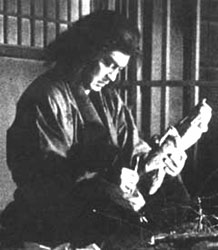 While Hiroshi Inagaki was finishing the last of his three-part color version of the life of Musashi Miyamoto (Samurai Trilogy with Toshiro Mifune) in the starring role at Toho Studios, Toei Studios had already released its offering. While Hiroshi Inagaki was finishing the last of his three-part color version of the life of Musashi Miyamoto (Samurai Trilogy with Toshiro Mifune) in the starring role at Toho Studios, Toei Studios had already released its offering.
Based on the brutally myth-demolishing novel Shisetsu Miyamoto Musashi (The True Story of Miyamoto Musashi, 1968) by Ryotaro Shiba (1923-1996), the tale considerably unravels the whitewashed view of Musashi that arose in the wake of Eiji Yoshikawa's well-known novel which inspired Inagaki & most modern portraits of Musashi's character as wholesome Zen quester.
Yasuo Kohata's Miyamoto Musashi (Toei, 1954) is the first post-war version to restore some of Musashi's "true" & least romantic nature. It starred Rentaro Mikuni, who'd been seen in Tomu Uchida's version as Priest Takuan Soho, & was Musashi's friend of youth, Matahachi, in Inagaki's version. Takuan was a heartwarming, amusing figure, & Matahachi a bit of a coward & fool.
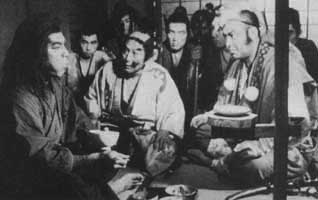 Mikuni's performance as Musashi is in stark contrast to either Matahachi or Takuan; & his interpretation of Musashi is again in stark contrast to the same figure as portrayed by Kinnosuke Nakamura in Uchida's six-film cycle, or Mifune in Inagaki's trilogy. Mikuni's performance as Musashi is in stark contrast to either Matahachi or Takuan; & his interpretation of Musashi is again in stark contrast to the same figure as portrayed by Kinnosuke Nakamura in Uchida's six-film cycle, or Mifune in Inagaki's trilogy.
Mikuni plays the role close to the historical Musashi as far as physical aspects are concerned, though the director may have been reactionary in making Musashi a drooling pig.
For the first & only time we see the man disheveled; he has no manners; he's dirty; in every regard he is the exactly contradiction of Inagaki's lily-white take. It's not insulting to history's Musashi at all, because we also see his spiritual side as he carves his bodhisattva deity, & it really isn't necessary to whitewash the man, which only reduces his complexity & interest.
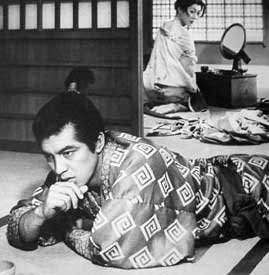 Kohata's film remarks upon Musashi's actual life in many curious ways. Historically, it appears that there was very little love lost between Musashi & his father, who hated his son from birth & only barely failed to kill him. Kohata's film remarks upon Musashi's actual life in many curious ways. Historically, it appears that there was very little love lost between Musashi & his father, who hated his son from birth & only barely failed to kill him.
So it isn't surprising to hear Musashi say in this movie, "When he died, I stomped on his grave! He can't get out!" Few are the samurai protagonists this void of filial piety.
According to some historians, the real Musashi had the appearance of a vagrant or a hermit, so dirty it was difficult to recognize his face, with torn & filthy garments dragging on the ground as he travels about the countryside bullying men & forcing them to duel.
Eiji Yoshikawa's popular romance of Musashi would have his uncleanliness a byproduct of his "wild youth" before he became a Zen scholar under Takuan's forced tutelage. But the evidence is he actually got worse as years passed. Though he certainly did become an author & lived a contemplative life when older, he remained unbathed thoughout. It is this reality Kohata is not the least bit reluctant to address, or Mikuni to portray.
The script sometimes seems to be commenting with dark humor on the myths created or perpetrated by Yoshikawa's novel. By so doing, Kohata turns the myths inside out & reinterprets them without necessarily going back to historical occurrences.
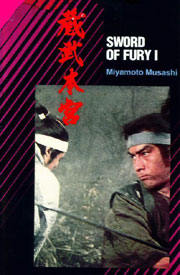 In 1973, Shochiku Studios released Tai Kato's updated two-part version of Miyamoto Musashi, this time with Hideki Takahashi in the title role.
In 1973, Shochiku Studios released Tai Kato's updated two-part version of Miyamoto Musashi, this time with Hideki Takahashi in the title role.
Hideki was best known as a yakuza-eiga or gangster film star, including in Tai Kato's epic version of the classic Theater of Life (Jinsei geki: Seishun aiyoku zankyohen, 1973).
Jiro Tamiya played Musashi's nemesis Kojiro in a subdued manner, & extremely pretty. Akemi is played by Mitsuku Baisho, best known as Tora's sister in the long-running Tora-san series.
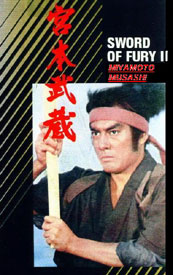 The director has a sardonic approach which, like Kohata in the 1954 version, refuses to romanticize Musashi. Tai Kato was not able to go so far as to have Musashi realistically vulgar in appearance; Hideki Takahashi is too handsome an actor for that, & more attractive still with long hair instead of the crew-cut of his gangster roles. The director has a sardonic approach which, like Kohata in the 1954 version, refuses to romanticize Musashi. Tai Kato was not able to go so far as to have Musashi realistically vulgar in appearance; Hideki Takahashi is too handsome an actor for that, & more attractive still with long hair instead of the crew-cut of his gangster roles.
Still, Musashi's spirit decidedly unrefined. He's not someone who goes from wild & naive to Zen purity. He is one hell of a mean bastard from start to finish.
Titled Sword of Fury I & Sword of Fury II in the subtitled release, the dual film allows us to hear Musashi's thought processes as he faces opponents & develops his fighting style.
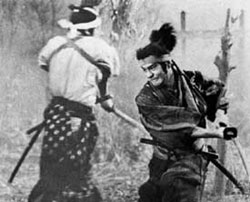 The story itself is the familiar one, & it's really only the "attitude" toward Musashi that is strikingly different, apparently influenced by the popular "new" yakuza-eiga attitude which had been shifting from the chivalrous gambler seen in Japanese gangster films of the 1960s to the merely violent gangsters of the 1970s. The story itself is the familiar one, & it's really only the "attitude" toward Musashi that is strikingly different, apparently influenced by the popular "new" yakuza-eiga attitude which had been shifting from the chivalrous gambler seen in Japanese gangster films of the 1960s to the merely violent gangsters of the 1970s.
In Part I we see the young would-be swordsman setting out to achieve greatness in war, achieving nothing because fighting on the losing side, & then beginning his long period of wandering & training, with the goal always in mind of his duel with Kojiro.
Part II builds toward that great duel on Ganryu Island, with considerable focus on Musashi's planning & forethought as to how to gain an advantage.
Rather than the Zen questor of Inagaki & Uchida's versions, we come to realize by watching Kato's film that this Musashi is a calculating, cold-blood trickster, scientific in his approach. This is close to the truth of Musashi's historical self, for he was an opportunist first & sentimentalist last.
copyright © by Paghat the Ratgirl
|
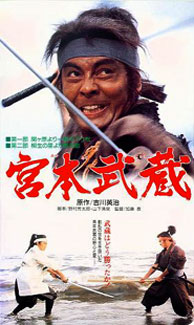

 Mikuni's performance as Musashi is in stark contrast to either Matahachi or Takuan; & his interpretation of Musashi is again in stark contrast to the same figure as portrayed by Kinnosuke Nakamura in Uchida's six-film cycle, or Mifune in Inagaki's trilogy.
Mikuni's performance as Musashi is in stark contrast to either Matahachi or Takuan; & his interpretation of Musashi is again in stark contrast to the same figure as portrayed by Kinnosuke Nakamura in Uchida's six-film cycle, or Mifune in Inagaki's trilogy. Kohata's film remarks upon Musashi's actual life in many curious ways. Historically, it appears that there was very little love lost between Musashi & his father, who hated his son from birth & only barely failed to kill him.
Kohata's film remarks upon Musashi's actual life in many curious ways. Historically, it appears that there was very little love lost between Musashi & his father, who hated his son from birth & only barely failed to kill him.
 The director has a sardonic approach which, like Kohata in the 1954 version, refuses to romanticize Musashi. Tai Kato was not able to go so far as to have Musashi realistically vulgar in appearance; Hideki Takahashi is too handsome an actor for that, & more attractive still with long hair instead of the crew-cut of his gangster roles.
The director has a sardonic approach which, like Kohata in the 1954 version, refuses to romanticize Musashi. Tai Kato was not able to go so far as to have Musashi realistically vulgar in appearance; Hideki Takahashi is too handsome an actor for that, & more attractive still with long hair instead of the crew-cut of his gangster roles. The story itself is the familiar one, & it's really only the "attitude" toward Musashi that is strikingly different, apparently influenced by the popular "new" yakuza-eiga attitude which had been shifting from the chivalrous gambler seen in Japanese gangster films of the 1960s to the merely violent gangsters of the 1970s.
The story itself is the familiar one, & it's really only the "attitude" toward Musashi that is strikingly different, apparently influenced by the popular "new" yakuza-eiga attitude which had been shifting from the chivalrous gambler seen in Japanese gangster films of the 1960s to the merely violent gangsters of the 1970s.